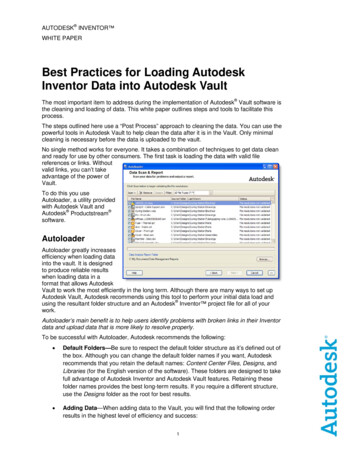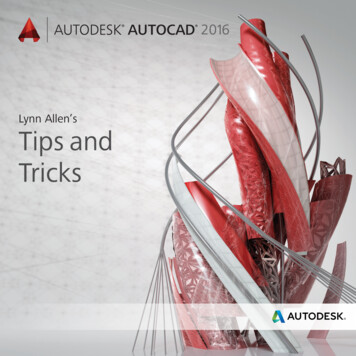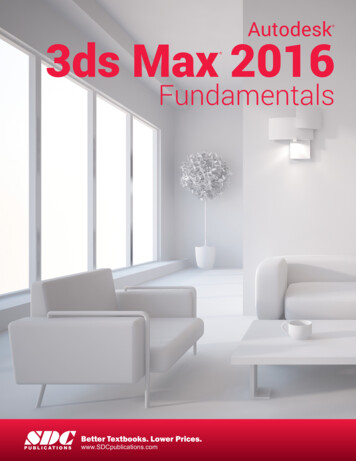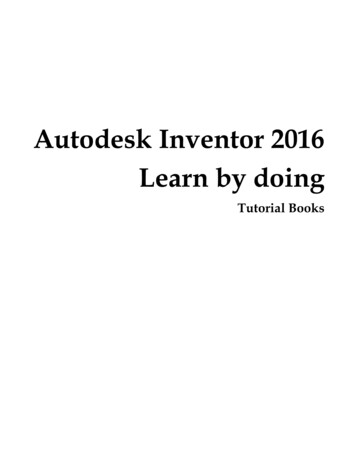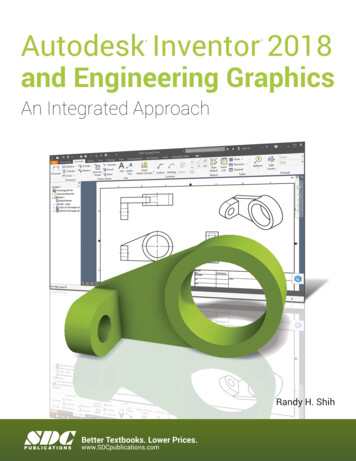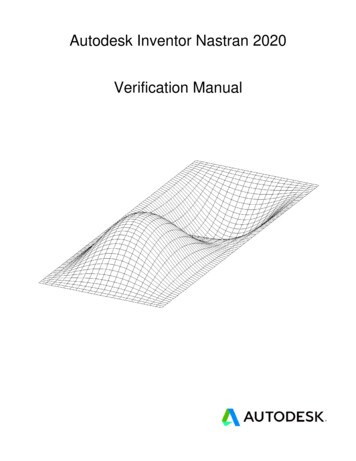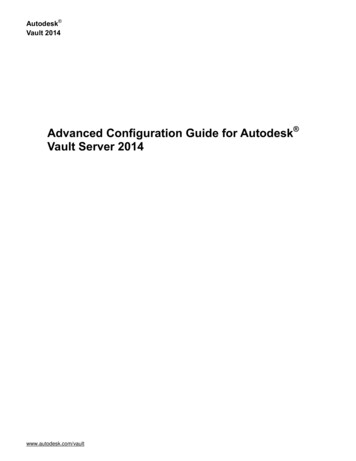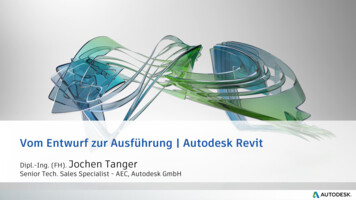
Transcription
Autodesk Maya 2013 2012 Autodesk, Inc. All Rights Reserved. Except as otherwise permitted by Autodesk, Inc., this publication, or parts thereof, may notbe reproduced in any form, by any method, for any purpose.Certain materials included in this publication are reprinted with the permission of the copyright holder.Portions related to RSA Data Security, Inc. MD5 Message-Digest Algorithm Copyright (C) 1991-2, RSA Data Security, Inc. Created 1991. Allrights reserved. License to copy and use this software is granted provided that it is identified as the "RSA Data Security, Inc. MD5 Message-DigestAlgorithm" in all material mentioning or referencing this software or this function. License is also granted to make and use derivative worksprovided that such works are identified as "derived from the RSA Data Security, Inc. MD5 Message-Digest Algorithm" in all material mentioningor referencing the derived work. RSA Data Security, Inc. makes no representations concerning either the merchantability of this software or thesuitability of this software for any particular purpose. It is provided "as is" without express or implied warranty of any kind. These notices mustbe retained in any copies of any part of this documentation and/or software.The following are registered trademarks or trademarks of Autodesk, Inc., and/or its subsidiaries and/or affiliates in the USA and other countries:123D, 3ds Max, Algor, Alias, Alias (swirl design/logo), AliasStudio, ATC, AUGI, AutoCAD, AutoCAD Learning Assistance, AutoCAD LT, AutoCADSimulator, AutoCAD SQL Extension, AutoCAD SQL Interface, Autodesk, Autodesk Homestyler, Autodesk Intent, Autodesk Inventor, AutodeskMapGuide, Autodesk Streamline, AutoLISP, AutoSketch, AutoSnap, AutoTrack, Backburner, Backdraft, Beast, Beast (design/logo) Built withObjectARX (design/logo), Burn, Buzzsaw, CAiCE, CFdesign, Civil 3D, Cleaner, Cleaner Central, ClearScale, Colour Warper, Combustion,Communication Specification, Constructware, Content Explorer, Creative Bridge, Dancing Baby (image), DesignCenter, Design Doctor, Designer'sToolkit, DesignKids, DesignProf, DesignServer, DesignStudio, Design Web Format, Discreet, DWF, DWG, DWG (design/logo), DWG Extreme,DWG TrueConvert, DWG TrueView, DWFX, DXF, Ecotect, Evolver, Exposure, Extending the Design Team, Face Robot, FBX, Fempro, Fire, Flame,Flare, Flint, FMDesktop, Freewheel, GDX Driver, Green Building Studio, Heads-up Design, Heidi, Homestyler, HumanIK, IDEA Server, i-drop,Illuminate Labs AB (design/logo), ImageModeler, iMOUT, Incinerator, Inferno, Instructables, Instructables (stylized robot design/logo),Inventor,Inventor LT, Kynapse, Kynogon, LandXplorer, LiquidLight, LiquidLight (design/logo), Lustre, MatchMover, Maya, Mechanical Desktop, MIMI,Moldflow, Moldflow Plastics Advisers, Moldflow Plastics Insight, Moldflow Plastics Xpert, Moondust, MotionBuilder, Movimento, MPA, MPA(design/logo), MPI, MPI (design/logo), MPX, MPX (design/logo), Mudbox, Multi-Master Editing, Navisworks, ObjectARX, ObjectDBX, Opticore,Pipeplus, Pixlr, Pixlr-o-matic, PolarSnap, PortfolioWall, Powered with Autodesk Technology, Productstream, ProMaterials, RasterDWG, RealDWG,Real-time Roto, Recognize, Render Queue, Retimer, Reveal, Revit, RiverCAD, Robot, Scaleform, Scaleform GFx, Showcase, Show Me, ShowMotion,SketchBook, Smoke, Softimage, Softimage XSI (design/logo), Sparks, SteeringWheels, Stitcher, Stone, StormNET, Tinkerbox, ToolClip, Topobase,Toxik, TrustedDWG, T-Splines, U-Vis, ViewCube, Visual, Visual LISP, Voice Reality, Volo, Vtour, WaterNetworks, Wire, Wiretap, WiretapCentral,XSI.ACE , TAO , CIAO , and CoSMIC are copyrighted by Douglas C. Schmidt and his research group at Washington University, University ofCalifornia, Irvine, and Vanderbilt University, Copyright (c) 1993-2009, all rights reserved.mental ray is a registered trademark of NVIDIA ARC GmbH, licensed for use by Autodesk, Inc.Intel is a registered trademark or trademark of Intel Corporation or its subsidiaries in the United States and other countries.OpenGL is a trademark of Silicon Graphics, Inc. in the United States and other countries.Python is a registered trademark of Python Software Foundation.All other brand names, product names or trademarks belong to their respective holders.DisclaimerTHIS PUBLICATION AND THE INFORMATION CONTAINED HEREIN IS MADE AVAILABLE BY AUTODESK, INC. "AS IS." AUTODESK, INC. DISCLAIMSALL WARRANTIES, EITHER EXPRESS OR IMPLIED, INCLUDING BUT NOT LIMITED TO ANY IMPLIED WARRANTIES OF MERCHANTABILITY ORFITNESS FOR A PARTICULAR PURPOSE REGARDING THESE MATERIALS.
ContentsChapter 1What's New in Autodesk Maya . . . . . . . . . . . . . . . . . . . 1Chapter 2What's New in General . . . . . . . . . . . . . . . . . . . . . . . 7Chapter 3What's New in Basics . . . . . . . . . . . . . . . . . . . . . . . 11Chapter 4What's New in File Referencing . . . . . . . . . . . . . . . . . . 13Chapter 5What's New in Animation . . . . . . . . . . . . . . . . . . . . . 17Chapter 6What's New in Rigging . . . . . . . . . . . . . . . . . . . . . . 23Chapter 7What's New in Modeling . . . . . . . . . . . . . . . . . . . . . 29Chapter 8What's New in Dynamics and nDynamics . . . . . . . . . . . . 31Chapter 9What's New in Rendering and Render Setup . . . . . . . . . . . 33i
Chapter 10What's New in Documentation . . . . . . . . . . . . . . . . . . 37Chapter 11What's New in MEL and Python . . . . . . . . . . . . . . . . . 39Chapter 12What's New in API . . . . . . . . . . . . . . . . . . . . . . . . . 45Index . . . . . . . . . . . . . . . . . . . . . . . . . . . . . . . . 47ii Contents
What's New in AutodeskMaya1Welcome to What’s New in Autodesk Maya 2013.Maya 2013 delivers new toolsets for dynamic simulation, rendering, and animation;implements an Open data initiative to facilitate non-linear workflows; and provides solutionsto create and maintain open pipelines.Enhancements to the Maya Nucleus framework, including the addition of a new Maya nHairmodule, combined with the new open source AMD Bullet Physics engine, help you createcomplex and realistic simulations.With the high-performance and high-quality Viewport 2.0, new features have been added toexpand the level of support, so artists can efficiently evaluate their work in a higher fidelityinteractive environment.1
Improvements to rigging tools, the ability to match Trax clips, enhancements to the GraphEditor, and a new Heat Map Skinning method offer an enhanced animation experience.Additionally, improvements to file referencing workflows and the support of Alembic andAnimation Transfer Object Model (ATOM) file formats make Maya 2013 easier to integrateinto open pipelines.GeneralAlembic files provide artists with a fast workflow forpassing complex scene data between various areas ofa production pipeline. The new Pipeline Cache toolslet you save and load scene files as Alembic-based cachefiles, which provide performance improvements including accelerated loading of large scenes, faster play backof complex character animations, and real-time playback of geometry data with topology changes.In addition, new single-step workflows let you sendscene data between Maya and 3ds Max.See What's New in General (page 7).BasicsThe new Node Editor lets you view, modify and createnode connections using an editable schematic thatdisplays nodes and the connections between their attributes. This interactive tool lets you build and editnetworks of nodes using a simple click-and-dragmethod.You can customize the Attribute Editor layout bycreating custom views and attribute controls for nodetypes and specific nodes. Customized XML-basedtemplates are loaded by selecting new options in theAttribute Editor Show menu.See What's New in Basics (page 11).2 Chapter 1 What's New in Autodesk Maya
File ReferencingNew File reference options in the Outliner make iteasier to manage your file references outside of theReference Editor. These options include new Reference menu items and a Reference Node display option that lets you locate and identify the loaded andunloaded file references in your scene.Similarly, other new features and options improve anumber of file referencing workflows. Now you canedit animation curves in referenced files, perform referencing operations on multiple references, view thecontents of unloaded references in your scene, andinclude files associated with unloaded references inthe scene archive.See What's New in File Referencing (page 13).ModelingThe Extrude Tool now has Thickness, Offset andDivisions values to allow for greater precision. Othertool improvements include the addition of a background colour for improved readability and the abilityto use Ctrl and Shift to more quickly adjust values.The new Brush strength slider in the Sculpt Geometry Tool lets you adjust the amount of pinchingthat is applied while sculpting.See What's New in Modeling (page 29).What's New in Autodesk Maya 3
AnimationWhen blending between clips of animation in theTrax Editor, new clip matching manipulators andoptions let you define an offset to properly align theclips in an animation sequence. Updated Trax Editoroptions include clip Offset settings for absolute orrelative offsets and Rotation Blend settings withsimpler Euler and Quaternion options.Maya's new ATOM file type gives animators a fastworkflow for repurposing existing animation as newcharacters are created. The .atom file type and its associated import/export options let you save specific posesor animation sequences, then easily reload them ontoother objects.In addition, the new Retime Tool lets you directlyadjust the timing of key movements in your animations. A new type of timing manipulator is availablein the Graph Editor that lets you shift or warp animation. Similar animation retiming tools are availablein other Autodesk applications. Other changes to theGraph Editor include updates to the View menuand toolbar icons.See What's New in Animation (page 17).RiggingThe new Heat Map binding method uses a heat diffusion technique to distribute weights, and gives youbetter results than the existing binding methods.Updates to the HumanIK character setup tools increaseusability and streamline common character setupworkflows: a unified interface lets you perform multipletasks in a single window; character layouts can becustomized to fit specific requirements; and HumanIKanimation is easily retargeted to and from a customrigged character.4 Chapter 1 What's New in Autodesk Maya
Additionally, new properties and options give youimproved control over roll bone behavior and animation rigs.See What's New in Rigging (page 23).Dynamics and nDynamicsThe nHair hair generation system is the newest addition to the Nucleus dynamic simulation framework.With the ability to self-collide and interact with otherNucleus objects, nHair has many advantages over theprevious hair system. Improvements include fasterperformance with a large number of follicles, bettercollision accuracy and control, the ability to createnConstraints, and nCaching for saving and playingback hair simulations.Maya now includes the MayaBullet physics simulationplug-in. Built from the Bullet physics library, the plugin lets you use the Bullet physics engine to create largescale, highly-realistic dynamic and kinematic simulations. MayaBullet simulations can include interactingsoft body and rigid body objects, as well as constrainedcollision objects, all contained in a single dynamicsystem within Maya.See What's New in Dynamics and nDynamics (page31).What's New in Autodesk Maya 5
Rendering and Render SetupNew Viewport 2.0 features include support for imageplanes and animation and rigging features such asHumanIK, joints, motion paths, ghosting and playblast.New polygons, NURBS and dynamics features havebeen added. Improvements in tumble and animationperformance of large scenes are also included.The new Mandelbrot node allows you to texture yourmodel with the Mandelbrot set. You can create a 2Dversion of this node (Mandelbrot), a 3D version of thisnode (Mandelbrot 3D), or shade a fluidShape nodeusing the built-in Mandelbrot texture.A new simplified workflow lets you automatically bakea substance texture to disk to render it with mental rayfor Maya, IPR, or other 3rd party renderers. Several newsubstance textures have also been added.See What's New in Rendering and Render Setup (page33).DocumentationRead about improvements to the search function in the Maya Help and the ability to sharehelp topics by email directly from your web browser.See What's New in Documentation (page 37).MEL and PythonRead about commands that have been added, changed, and removed for this release.See What's New in MEL and Python (page 39).APIYou can now easily create a distributable deployment of your plug-in. This way, makingchanges to the plug-in is simple even across multiple Maya versions and platforms.Additionally, a new module file syntax allows multiple versions of a plug-in to be supported.See What's New in API (page 45).6 Chapter 1 What's New in Autodesk Maya
What's New in General2Pipeline cachingNew Pipeline Cache tools let you load, save, and playback Maya scenes as Alembic cache files. The Alembicfile format is an open-source format developed for exchanging complex 3D geometry data. Alembic files arehighly portable and application-independent so theycan be shared, processed, and played back by manycontent creation applications.Alembic caches provide several performance improvements, including accelerated scene loading of largescenes, faster playback of complex character animation,and real-time play back of geometry data with topologychanges. Alembic files also let you share large scenesbetween various areas of a production pipeline withoutthe large memory overhead of fully editable scene files.Options in a new Pipeline Caching menu let youconfigure settings for loading and saving Alembic files.Interoperability with 3ds MaxTransfer data between Maya and 3ds Max using the newSend to 3ds Max command in the File menu. Youcan send various forms of data, including geometry,animation, materials, and textures, to 3ds Max. Youmust have matching versions of Maya 2013, 3ds Max2013 and FBX 2013 to use this command.7
Run Maya with a Simplified Chinese interfaceMaya is now available with a Simplified Chinese interface. For instructions on how to run Maya with aSimplified Chinese interface on different operatingsystems, see Run Maya with a Japanese or SimplifiedChinese interface.Live update serviceCheck for updates including Service Packs and Hotfixesusing the new Autodesk Maya Update Manager (Help Check for Updates).This window lists updates that are available for yourversion of Maya, and lets you check for updates usingdownload codes.New Bonus ToolsThe new Attribute Editor Template Builder tool helps you build custom AttributeEditor templates. You can download Bonus Tools from the Autodesk website by selectingHelp Download Bonus Tools in Maya.New suites specific environment variablesSeveral new suites specific environment variables let you run Maya off a network when itis used as part of the Autodesk Entertainment Creation Suites. See Suites specific environmentvariables.8 Chapter 2 What's New in General
Autodesk MatchMover scripting supportAutodesk MatchMover now includes Python scripting support. Use MatchMover's ScriptEditor and Script Manager to create and load scripts that process input and output dataas well as launch interface commands.Autodesk Composite QuickTime movie supportYou can now select the QuickTime movie (.mov) file format as a Render output for yourComposite projects. By default, QuickTime uses the H.264 codec. You can select resolutionsup to 1080P.What's New in General 9
10
What's New in Basics3Node EditorThe Node Editor presents an editable schematic of thedependency graph, displaying nodes and the connections between their attributes. It allows you to view,modify and create new node connections. You can access the Node Editor from the Windows menu. (Window Node Editor).You can graph the network of nodes of your choice,and build networks by using the Tab key and dragginglines from one node to another. Using this method,you can easily edit existing networks. All attribute portsand connection lines are represented by different colorsso that connections can be easily read. In addition, youcan create bookmarks to return to previous graph layouts for easy navigation.Attribute Editor updatesNow you can customize the Attribute Editor window in several different ways:Custom Attribute Editor templatesYou can edit the way attributes are displayed in the Attribute Editor by creating XML-basedtemplate files for specific nodes and node types.A template can have one or more views associated with it. Each view describes a particulardisplay layout and can be used to tailor the interface for different purposes. After applyingyour custom template, you can access your views from the Show menu in the AttributeEditor.Custom callbacks11
You can use MEL or Python based callbacks to link an attribute to a control or a complexscript. Using the description language "cb" tag in your custom Attribute Editortemplate lets you specify a callback command and links your callback to an attribute.Use node type filtering to improve Attribute Editor performanceWhen making a selection in Maya, having the Attribute Editor open may causeperformance delays if too many nodes related to the selection are displayed as tabs. To avoida slowdown, you can use node type filtering to customize which related nodes are displayedin the Attribute Editor.Creating attributes using attribute patternsYou can create dynamic or extension attributes using attribute patterns. An attribute patternis a description of the dynamic or extension attributes that can be added to any specificnode, or node type. Using this feature, you no longer need to create each attribute usingindividual addAttr or addExtension commands.This feature is supported by the pyJsonAttrPatternFactory.py plug-in.Editing the file path in the file browserYou can now edit the file path in the Look in field of the file browser and use its autocompletion functionality.12 Chapter 3 What's New in Basics
What's New in File Referencing4File referencing options in the OutlinerReference node displayA new Reference Node display option in the Outliner makes it easier to locate and identify all theloaded and unloaded file references in your scene. Youcan access the option in the Outliner by selectingDisplay Reference Nodes. The Reference Nodesdisplay option is on by default.Create and manage file referencesNew Reference menu items in the Outliner let youcreate and manage file references without opening theReference Editor. In the Outliner,-click a reference node or referenced object to access file referencing commands.Allow Referenced Animation Curves to be EditedYou can now edit animation curves from referencedfiles. These changes are managed by the reference nodelike other reference edits. You can modify an animationcurve, such as changing tangent types or editing keyframes, then export the updates as reference edits to anoffline file.13
To edit animation curves in referenced files, you mustturn on Allow Referenced Animation Curves tobe Edited in the Referenced Animation Curvessection of the Animation Preferences.File referencing improvementsMaya 2013 includes a number of new file referencing features and options that improve filereferencing workflows.Updated reference node Attribute EditorAn updated reference node Attribute Editor displays information about reference nodes,such as file path, namespace, and sharing details.Operations on multiple referencesUsing the file referencing options in the Outliner, you can now perform referencingoperations on multiple references including the following: Loading, unloading and reloading Importing Locking and unlockingPreview unloaded contentA new Preview unloaded content option lets you view the hierarchy of the unloadedreferences in your scene without loading the reference in the scene.Archiving unloaded referencesAn option has been added to scene archiving that lets you include files associated withunloaded references in the scene archive.Namespace updates and improvementsMerge into selected namespaceA new Merge into selected namespace option lets you choose to merge referenced orimported object namespaces with a namespace that exists in the parent scene. Whenduplicate namespaces occur, the namespaces are merged and duplicate object names areincrementally suffixed with a number.14 Chapter 4 What's New in File Referencing
This new option lets you keep duplicate namespaces and avoids an accumulation of newnamespaces each time your referenced or imported objects have the same name.You can access the Merge into selected namespace option in the Reference Options,Import Options, and Assign Offline File Options windows.New MEL CommandsNamespace MEL commands have been updated to allow easier manipulation of namespaces.These new command updates include: The namespaceInfo command has several new flags for querying information about anamespace. New flags allow for namespace names to be returned in various formats:baseName, absoluteName, and fullName. The isRootNamespace flag determines whetherthe namespace is the root namespace. The namespace and file commands have new operations for namespace management:mergeNamespaceWithParent and mergeNamespaceWithRoot. The namespace commandalso has a new collapseAncestor option. For referenceQuery, the flags -namespace and -parentNamespace query the fullnamespace path of a referenced node, file, or its parentNamespace. The ls command has additional functionality related to namespaces. The -showNamespaceflag returns object/namespace pairs. The -absoluteName flag can be used with ls-showNamespace, to return the absolute namespace names regardless of current namespaceor relative namespace state. For example: ls -showNamespace -absoluteName. You can now rename and create nodes using absolute namespace paths. For example::ns1:ns2:mySphere.What's New in File Referencing 15
16
What's New in Animation5Live character streamingThe options in the new Live Connection window ( Edit Live Connection or File Send toMotionBuilder Live Connection) are an extensionof the Send to commands that were introduced inMaya 2012. Now you can send your HumanIK definedcharacter to MotionBuilder and establish a live streaming connection.This new workflow lets you drive your skeleton orCustom rig with motion capture data, so you can previsualize your retargeting result before baking the finalanimation from MotionBuilder into your Maya scene.NOTEThis feature is only available if Maya is usedas part of the Autodesk Entertainment Creation Suites.Improved import and export with ATOM file formatYou can now share and reuse animation more efficientlyusing Maya's ATOM (Animation Transfer Object Model).The .atom file type and its associated import/exportoptions let you save specific poses or animation sequences, then easily reload them onto other objects.ATOM options let you set precisely which animationto reuse and how you want to import and export it.After exporting, you can import animation based onthe character hierarchy, name matching, or using atemplate file as a filter.17
NOTE The .anim file format, animImportExport.mll plugin, and its related options remain available from the File Export Selection and File Export All menu items.Nonlinear animation improvementsClip matchingWhen manipulating clips of animation in the TraxEditor, new clip matching tools let you define anoffset object to better align the movements in youranimation sequence.More easily set relative or absolute clip offsetsUpdated clip Offset settings are now included in theCreate Clip Options (Animate Create Clip )and in the Trax Editor context-sensitive menu, lettingyou more easily view and set whether channels havean absolute or relative offset from the previous clip.See also Offset clip channels.NOTE Absolute is now the default Offset option fornew clips and imported clips.Other updatesThe Rotation Blend setting in the Blend Clip Options (Create Blend ) has been updated withsimpler Euler and Quaternion options. Quaternionis now the default Rotation Blend setting when youcreate a blend between animation clips. See Trax menubar for updated information.18 Chapter 5 What's New in Animation
Retime animationIn the Graph Editor, the Retime Toollets youdirectly adjust the timing of key movements in youranimations. This tool provides a new type of timingmanipulator in the graph view, letting you shift keymoments in time, or warp entire sequences to makethem occur faster or slower.For animators working in a pipeline with multipleAutodesk applications, similar animation retimingtools are available in 3ds Max, Softimage, and MotionBuilder.Converting CAT to HumanIKThe new Send to commands in Maya and 3ds Maxlet you convert a CAT bipedal character into a Mayacompatible HumanIK character. This direct connectionlets you transfer your character structure, definition,and animation from 3ds Max into an FK representationon a HumanIK skeleton in Maya. Any changes or newanimation that you create in Maya can be updated onyour original CAT character, so you can continue toanimate in the context of your 3ds Max scene.NOTEThis feature is only available if Maya is usedas part of the Autodesk Entertainment Creation Suites.Other Graph Editor updates Updated Buffer Curve options Graph Editor Curves menunow let you create a snapshot of referenced curves. See Editanimation curves in referenced files. The Add Key Tool (originally available in the Graph Editortoolbar) is now only available from the Keys menu. The original Add Key iconnow represents the Insert Keys Tool.See also Add keys to a curve.What's New in Animation 19
View framing options (Frame All, Frame Selection, FramePlayback Range) are now grouped in a View Framemenu.Stepped Tangent preview modeThe new Stepped Tangent preview playback mode lets you temporarily set all keys todisplay with Stepped tangents, switching easily from Spline to Stepped and back. Play youranimation in this mode to get a quick view of object positions as they hit each keyframe.To turn the playback mode on and off, right-click the Time Slider and toggle the EnableStepped Preview option.NOTE The original tangents are preserved and restored when you turn Enable Stepped Previewoff.Keyframe and Tangent marking menu updatesThe marking menus available for editing keyframes and tangents have been updated toallow manipulation of motion trails, keys, and tangents directly in the scene view. To accessthe updated marking menus, press S , then select the Keys or Tangentsmenu for more options. For example, the Keys menu contains options to let you copy andpaste keys on a motion trail, while the Tangents menu lets you quickly change the tangenttype for a selected key.NOTE The Tangents menu available from S replaces the former S marking menu.Camera Sequencer improvementsYou can now create an ubercam for camera shots that are keyed with weighted curves. Inaddition, sequences with gaps between camera shots are now handled correctly. See Createa single camera for all shots in a sequence.Improved baking optionsNew options in the Character ControlsBake menu let you bake animation to a HumanIKskeleton, Control rig, or Custom rig. The Bake menu updates dynamically to display optionsthat reflect the current character's state.20 Chapter 5 What's New in Animation
New Playblast featuresMaya now supports H.264 Quicktime output on Windows 64-bit. In addition, audio andmulti-track audio are supported.What's New in Animation 21
22
What's New in Rigging6Updates to the character setup toolsUnified Character ControlsThe new Character Controls let you perform multiplecharacter setup tasks in a single window.As you set up your character, the previously independent HumanIK tools appear as tabs in the consolidatedCharacter Controls, simplifying the character set upprocess.The Skeleton, Definition, Controls, and CustomRig tabs appear as you select options from the Startpane, Source menu, or Character Controls menubutton.Start paneBegin the character setup process using the Start panein the Character Controls window. Whether you arecreating a new HumanIK skeleton from scratch, definingan existing skeleton, or adding a Control rig or Customrig mapping to your character, this pane is designed toguide you through the setup process.Source managementThe new Source menu provides feedback about the typeof source driving your character. The Source menu isavailable in the Character Controls window at alltimes, regardless of the HumanIK tool that is active.23
This menu updates dynamically as you work to reflectchanges to the character state. You can also set yourcharacter's source type by manually selecting an optionfrom the drop-down menu.Custom Rig MappingThe new Custom Rig tool gives you a visual interfacefor mapping your non-HumanIK rigs.Designed to streamline the mapping and retargetingprocess, this tool lets you map and retarget bipedalHumanIK character animation to and from a Customrigged character. You can define your rig using the familiar click-and-assign workflow.Other controls let you save and load mapping templates and adjust the offsets between a Custom rig andthe character's skeleton joints.Customizable character layoutYou can now customize the character layout in theCharacter Controls to fit your character.The layouts for the Controls and Custom Rig tabsare available as user-editable XML files, located in thenew CharacterControls directory. Editing these fileslets you create custom layouts. For example, you canreplace the background image or change the position,quantity, color, and size of cells.24 Chapter 6 What's New in Rigging
Heat Map bindin
Welcome to What's New in Autodesk Maya 2013. Maya 2013 delivers new toolsets for dynamic simulation, rendering, and animation; implements an Open data initiative to facilitate non-linear workflows; and provides solutions to create and maintain open pipelines. Enhancements to the Maya Nucleus framework, including the addition of a new Maya .


